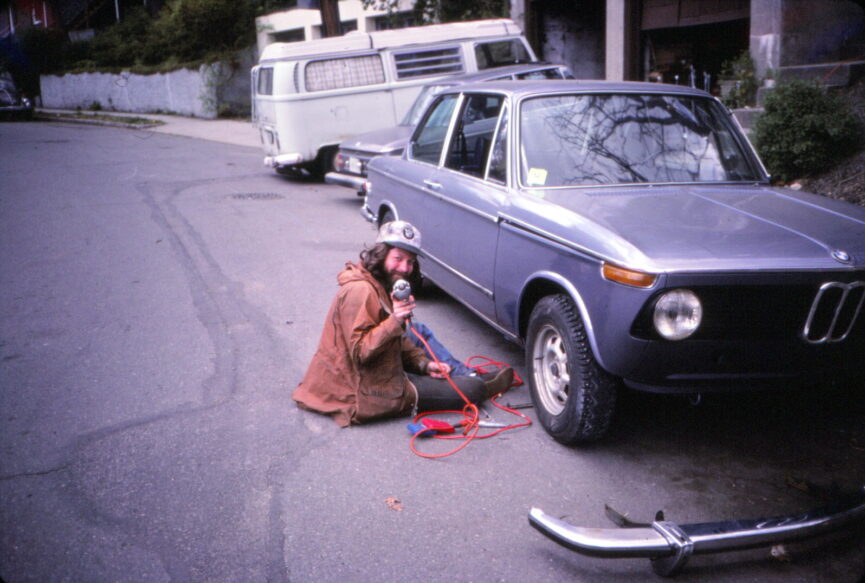There are a few bedrock events in my BMW history. I’ve told and retold the story of the Hampshire College student who lived with us in Amherst when I was in junior high school who had a 1970 2002 with a license plate that said “GEIST” (German for “spirit”), and who forever impressed me with what that boxy little Teutonic sedan could do. And I’ve written about moving to Austin in 1982, buying my first 2002 (a ratty ’71 that needed the transmission rebuilt), and how that kicked off an avalanche of wrenching that largely continues to this day.
But the other seminal event was our return to Boston in 1984 and getting unfettered use of my mother’s two-car garage. Maire Anne and I were getting married, our families were both in Boston, and we decided to pre-emptively move back instead of returning to Austin where we’d likely buy a house, have kids, and get dug in. We drove up in two vehicles—Maire Anne driving her ’69 VW camper, and me in a U-Haul truck towing Bertha, the rust-free ’75 2002 I’d recently purchased. We had no jobs and nowhere to live, but my mother had recently purchased a fifteen-room Victorian house just off Cleveland Circle in Brighton that she and my sister had turned into a quirky three-family residence with the first and second floors connected and the third floor as a separate rentable apartment. She offered us the apartment until we decided what we wanted to do. I guess it took a while for us to figure that out because we were there for eight years. My sister and I later joked that our mother bought the house, then shamelessly tricked her adult children into moving in with her.

My mother’s house in Brighton where Maire Anne and I lived for eight years.
I don’t remember what conversation I had with my mother and sister about the house’s two-car garage. I doubt that I said “You know, I’m going to fully commandeer both bays. Both of you will need to park on the street.” But that’s pretty much what happened. I’m still not sure how I got away with it.
My relationship with the garage initially didn’t go well. We were only in the house for a few weeks when I was backing Bertha out of the garage, had the driver’s door ajar to look behind me, and caught the edge of the door on the garage’s door jam, denting the door and preventing it from closing. This was a problem, as Maire Anne and I had a honeymoon road trip planned. I ordered a replacement door, it arrived, I shot it in gray primer, and installed it on Bertha, fully expecting that, sometime soon, I’d get the entire car repainted (it was rust-free, but for unknown reasons the originally Polaris car had been repainted gray, and the paint had the consistency of cement). 39 years later, I still own Bertha, and she’s still wearing the primer-colored door.
I think the first car that I bought after moving back was a rusty Inka ’72 2002tii that I intended to use as a winter beater to keep Bertha off the road during the “rust months.” I had designs on making Bertha a Kugelfischer-powered fuel-injected car, so I pulled the engines out of both Bertha and the tii and began to swap them, Frankenstein’s monster-style, in the two garage bays. I got Bertha’s engine into the tii, but then soon happened into a rusty ’71 2002ti with a bad engine. The ti—the dual-sidedraft predecessor of the tii—is now a rare and sought-after never-imported 2002 variant, but back then it was just another rusty 2002. So I wound up dismantling the ti curbside (which no doubt endeared me to my new neighbors), stashing the parts under my mother’s front porch, and using the ti as a parts source for turning Bertha into something of a ti tribute car. A few months later, Bertha’s alternator light went on. I opened the hood and was surprised to see the fan not turning but the fan belt still intact. It took me a while to understand that the woodruff key holding on the crankshaft pulley had sheared off and ruined the front of the crankshaft. I had to pull the engine back out and install the crankshaft from the ti. For reasons I can’t quite recall, I wound up using the block from the tii and the head and dual sidedraft Webers from the ti. Like the primer door, all these components still exist in Bertha to this day.

Bertha in my mother’s garage in 1986, streaming out antifreeze and contributing to the pollution in Boston Harbor like a real Bostonian. I think that’s a subframe from a 2800CS standing up against the right wall.
The point in all of this is that I did an insane amount of wrenching in that garage. I chronicled nearly all of it when I began writing for Roundel magazine in 1986. There was the 1600 I bought as the next winter’s beater whose clutch was so bad that it had trouble going up hills, and which lost a wheel that I then had to chase after. There were easy cars like the $700 530i that needed only fresh spark plugs. There were hard cars like the Bavaria whose rough-running turned out to be due to the valves on #1 cylinder barely opening because the banjo bolts holding the oil distribution pipe had loosened, causing the rocker arms to wear grooves in the cam lobes. There were cursed cars like the Euro E21 323i that I sold, told the buyer to replace the timing belt IMMEDIATELY, he didn’t, it broke, and I bought it back under threat of lawsuit (in retrospect, I should’ve told him to pound sand, but he did have it painted before the belt broke). There were do-the-right-thing cars like the ’73 tii that I bought, revived, sold to a kid in Roxbury, and when he came by for a visit afterward, I noticed that the rear wheels were cambered outward like some stanced caricature because the rear subframe had broken. I replaced it for him at no cost with the subframe from the ti I parted out.
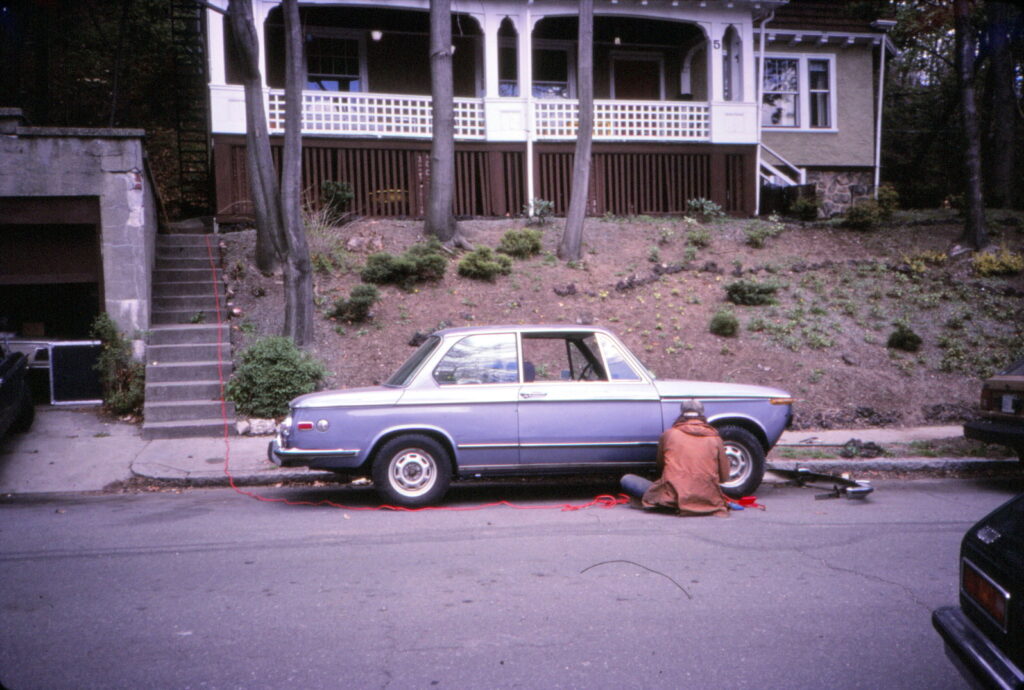
If you look carefully, you can see a square tail light tii in the garage. With Bertha and the tii I’m working on curbside, that was three 2002s. While living in Boston a stone’s throw from Comm Ave. I was out of control even then.
Of course, there was my E9, the ’73 3.0CSi I still own. When I bought the battered dented bondo’d partially disassembled car in 1986, it arrived on a flatbed. I put the interior and glass in it nursed it back to heath, and drove it for a year looking like the wreck that it was. I had a new nose and fenders installed in 1987, then had the car painted in 1988. Shortly after, I found another E9, a white ’75 with a tan leather interior that came in through Saudi Arabia. I craved having the tan leather interior in the red car, so I bought it and swapped interiors.
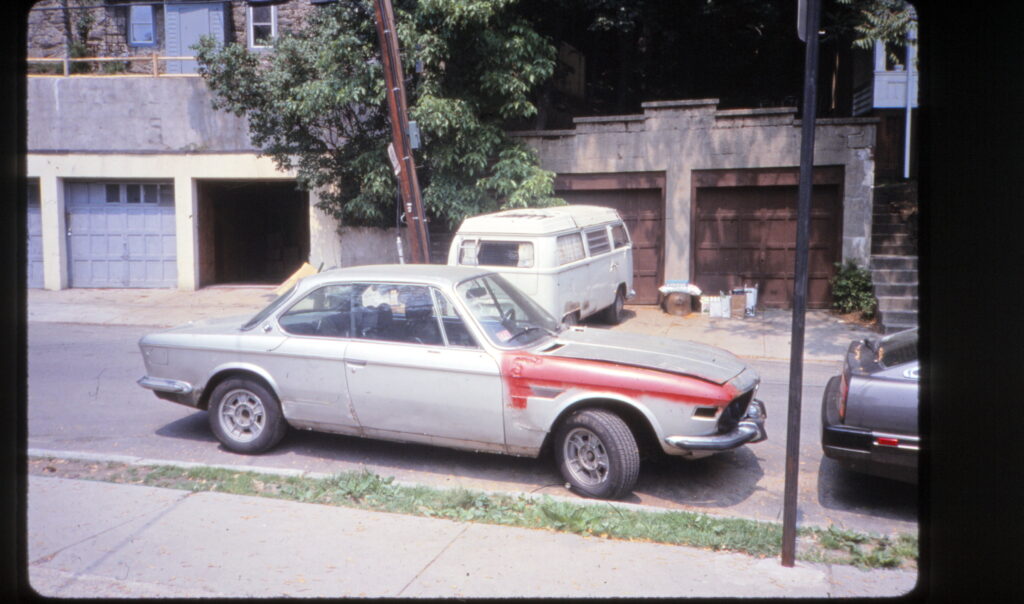
The E9 after purchase and partial reassembly. Look at that booged-up bodywork!
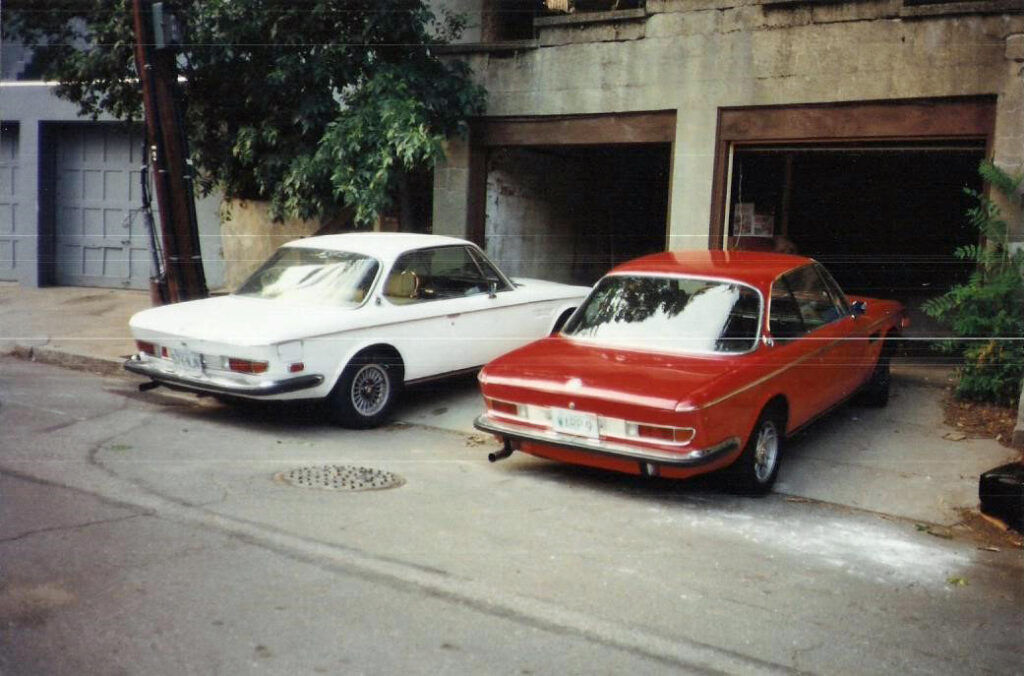
Having two pretty shiny E9 coupes improved the property values after the curbside 2002ti part-out.
Then I happened into an engine from a low-mileage E28 533i for a price I couldn’t refuse. I can’t recall if I did the engine swap curbside because I didn’t have the ceiling height in the garage to use the engine hoist or because both garage bays were occupied with other projects, but curbside is where it happened. The photo below, taken outside the garage, was used in the 1988 Roundel article “The Life, Death, and Life of a Coupe.”
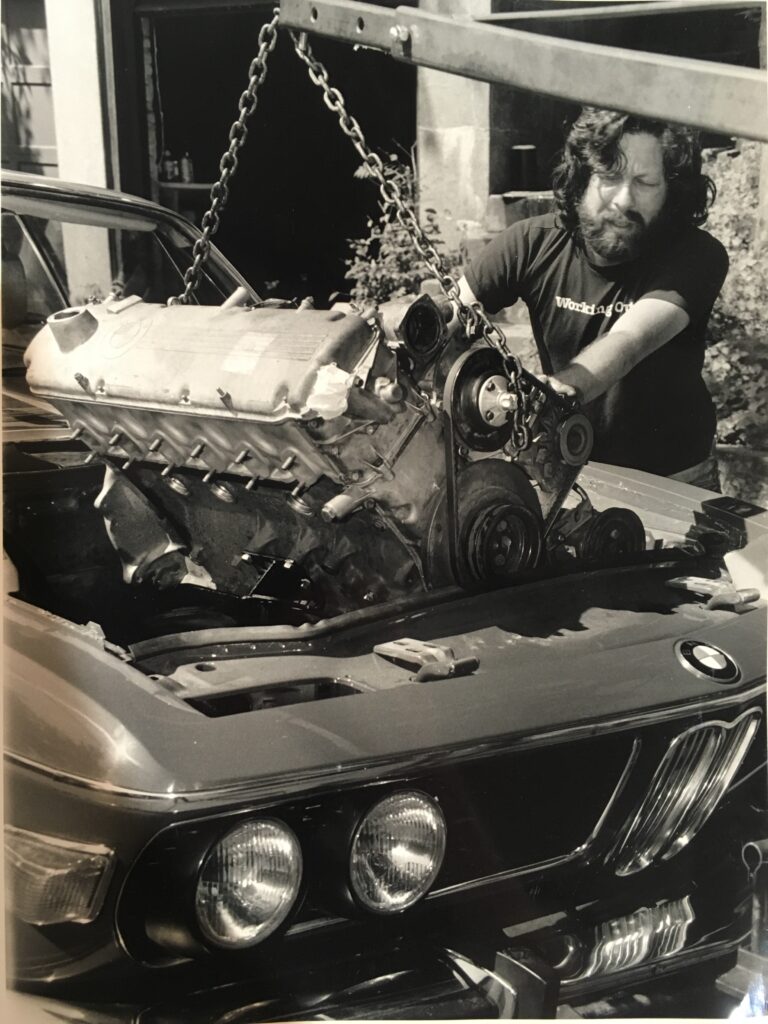
Photo by Yale Rachlin.
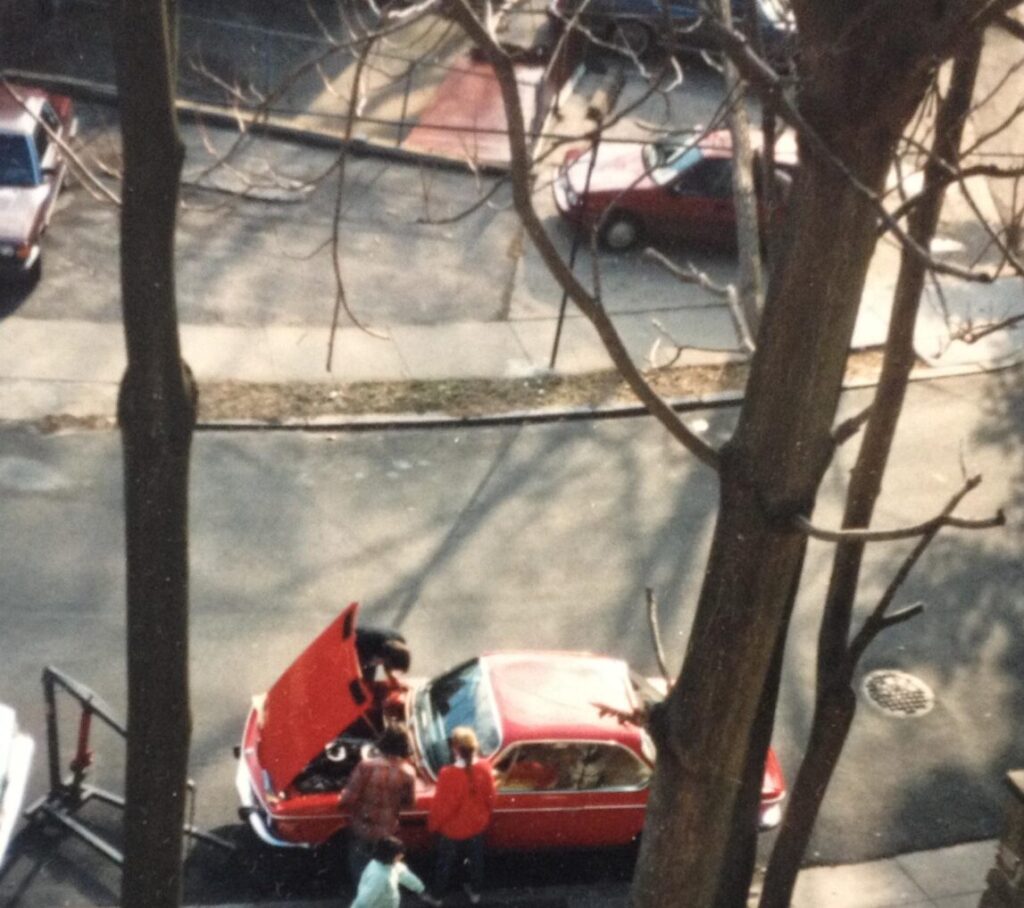
A view of the curbside E9 engine swap from our 3rd-floor apartment.
Then there was the E9 parts car incident. I bought two 2800CSs. One was rusty but running and drivable, sort of. The other was a dead parts car. Both were being sold out of a junkyard north of Boston. I stripped the dead one where it sat, stashed the parts—you guessed it—under my mother’s porch, and drove the running one home. So for a while I had three running E9 coupes in Brighton. The pretty two were stored in the garage. The rusty 2800CS stayed on the street which was dicey because it was unregistered. I planned to use it as a winter beater, which totally fit with my Hack Mechanic self image, but I played too many games with swapping license plates, the City of Boston got wise, and towed it and crushed it.

The beater 2800CS bringing up the rear of the three-E9 conga line in front of my mother’s house.
Somewhere during this whirlwind of activity, I realized that if I was acting like a real mechanic, I should have more of the tools of a real mechanic. I vividly remember driving to a local Sears, buying the 2 1/2 hp 20-gallon compressor that I still own, ordering the impact wrench and hose from Harbor Freight and Salvage back when you had to do it through a paper catalog, hooking it all up in my mother’s garage, jacking up a car, squeezing the trigger on the impact wrench, hearing that first whacketa-whacketa-WHEEEE, and feeling like I’d arrived.
There were non-BMWs as well. There was my wife’s VW camper that was her daily driver until the kids were born. Then there was a succession of six Vanagons. And there was the ’86 Alfa Spider I bought with a blown head gasket. All wrenched on in my mother’s garage.
Obviously, there were non-automotive things going on in the house as well. I realize that not every young married couple can move in with the husband’s family, but it worked out great. My family and Maire Anne adored each other. My first two kids were raised in the house with their cousins and grandmother downstairs. And my mother, with both of her children and all of her grandchildren living with her, was in heaven. Regarding exactly why my mother let me completely monopolize the garage, leaving her and my sister to park on the streets in the winter… well, she had boundless generosity for her family, and an uncanny knack for figuring out what we each needed. Hell, the whole shared house was an example of that. Did I mention that she also had a rehearsal room built in the basement so the band Maire Anne and I were in had a place to practice, and had an addition built on the back when the expanding number of grandchildren started to bust the house at the seams?
In 1992, after eight years living on the third floor of my mother’s house, Maire Anne and I were expecting our third child, and bought the house in Newton where we still live. The house had a tiny rusting leaning corrugated metal single-car garage with barely enough room to walk around a car, so it was a huge step down from the the garage in Brighton. Further, since the tiny new dilapidated garage had to hold my recently-painted E9 coupe, and since there was no other storage space, it effectively clamped my purchasing habits, at least regarding older cars. I continued to go through cars, but the gentleman’s agreement I had with myself was that they had to be cars that could sit outside—they couldn’t be rust-prone classics. Before we moved, I sold Bertha to my friend Alex, who promised to keep it garaged. I sold the Alfa and a recently-purchased Vanagon camper as well. It wasn’t until our three-car garage was built in 2006 that I began buying 2002s and other vintage BMWs again.
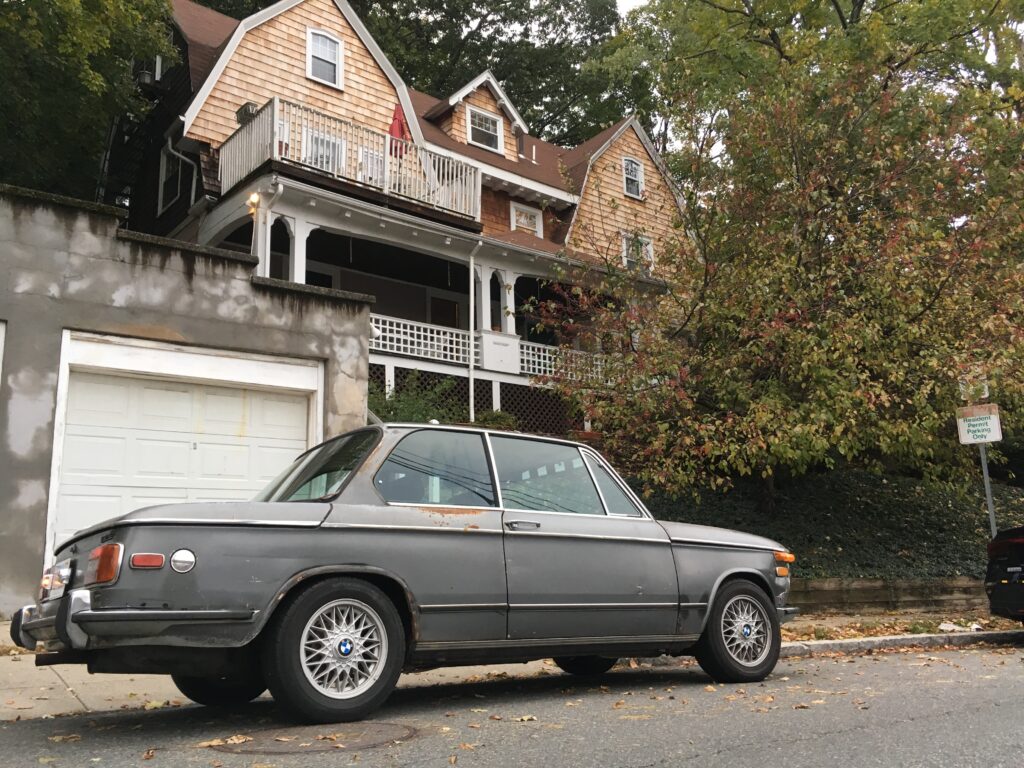
Bertha in 2020, making a return trip to the scene of many crimes 35 years later.
About eight years ago, my mother gently asked me—for the fourth time—to get rid of my accumulation of parts under her front porch. I separated the wheat from the chaff, put out the message to local 2002 and E9 groups that I was having a “take ’em they’re free” sidewalk sale, and got rid of multiple doors, differentials, transmissions, and rear subframes. Things I still wanted or things that were destined for the scrap bin went in the back of the Suburban.
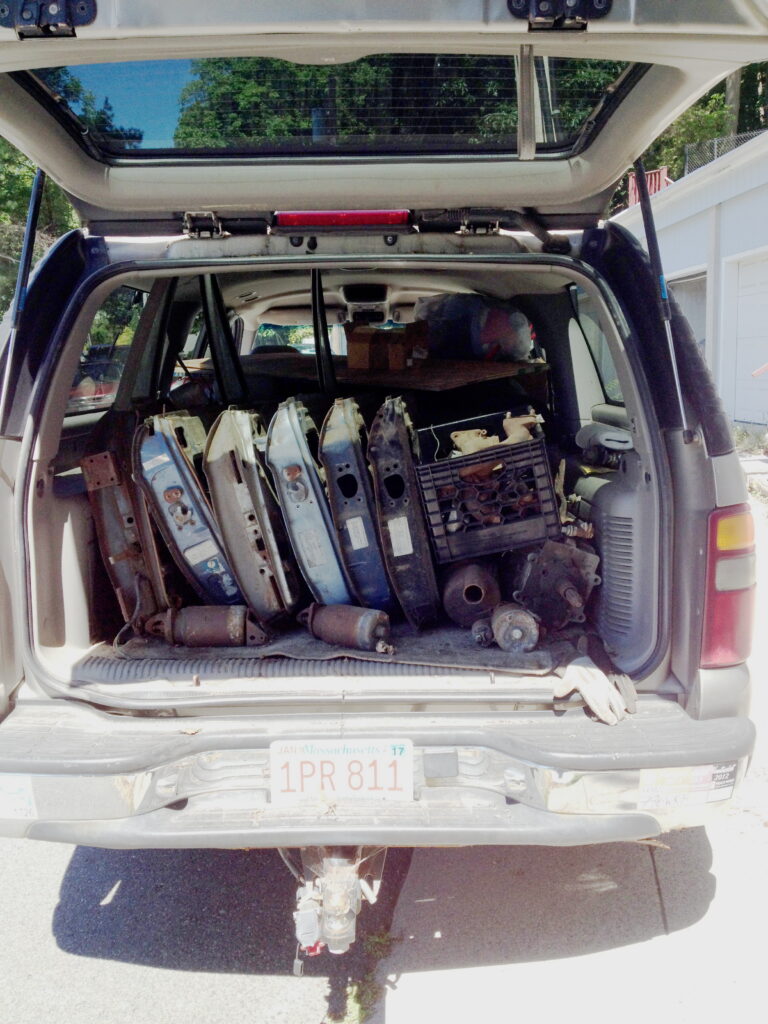
More than I really wanted to deal with, but what I felt I needed to do.
My mother passed away in 2019. My sister and I inherited the house. She and her husband still lived there, as did my youngest son who was renting our old 3rd floor apartment. Last winter she decided that she’d had enough of the upkeep of the big old place, and we began the slow process of emptying the house of 40 years of family occupancy and readying it to sale. This spring, I wrote about dealing with the spare E9 front subframe and my E9’s original numbers-matching engine, both of which were still sitting in the garage after 34 years. It turned out there were three rear windshields and a differential still hiding in the basement as well.
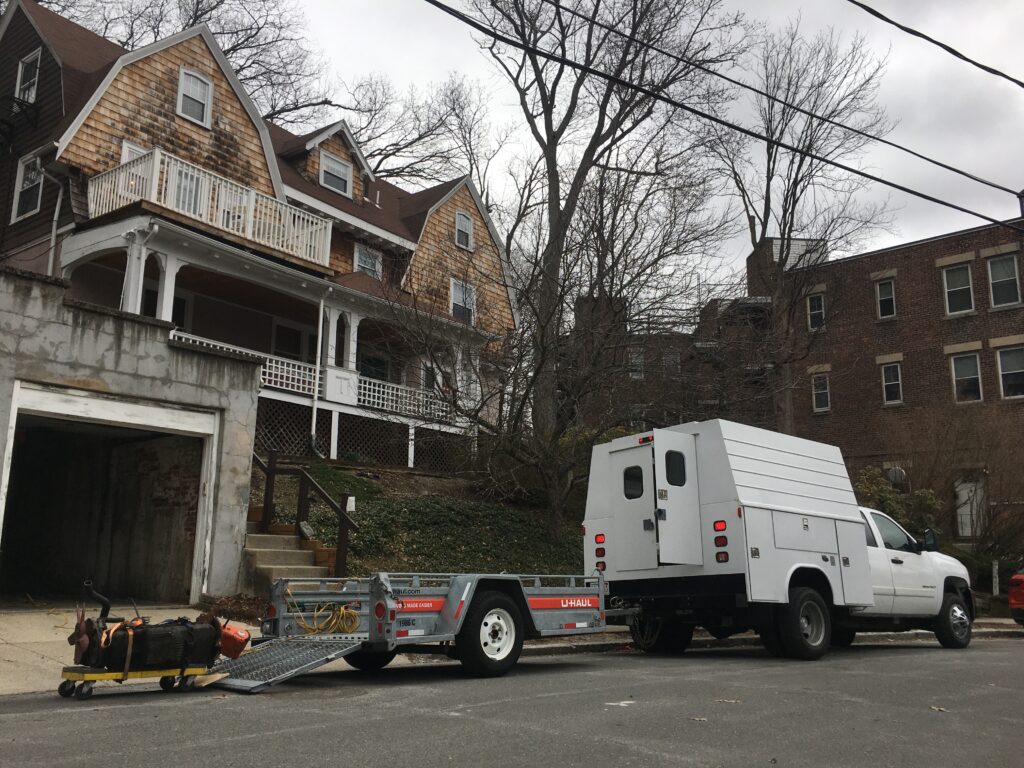
Moving that engine, I felt like an undertaker.
In late June, once the house was emptied of both people and things, we put it on the market. In this climate of rising interest rates, it took a little while to find a buyer, but we closed on the sale last Wednesday.
So, goodbye to my mother’s house and to its glorious two-car garage. It wasn’t ground zero for me for wrenching (to be clear, that was actually the little carport my mother’s previous house in Amherst where I worked on my Triumph GT6+ when it was broken, which was probably about half the 2.5 years I owned it), but it was where I really got my automotive legs under me. I doubt that the whole Hack Mechanic thing would’ve unfolded had Maire Anne and I moved back from Austin to a regular garage-less apartment where we were at the mercy of on-street parking. The new owner is an entity rather than a private party, so it’s unlikely a new generation of gearheads will indulge their passions and skin their knuckles inside. But maybe some of that vibe will still resonate inside its walls. Who knows? Maybe someone will come out to find a flat tire, begin to change it, be stymied by a stuck lug nut, and hear a long-forgotten ghost saying whacketa-whacketa-WHEEEEEE…

Farewell, old friend. Thanks for the memories. And thanks, ma…
—Rob Siegel
____________________________________
Rob’s newest book, The Best of The Hack Mechanic, is available here on Amazon, as are his seven other books. Signed copies can be ordered directly from Rob here.

